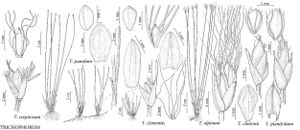Trichophorum planifolium
Oesterr. Bot. Z. 63: 402. 1913.
Plants densely cespitose; rhizomes absent. Culms trigonous, 10–40 cm, scabrous proximal to inflorescence. Leaves: basal sheaths brown; distal leaf-sheaths concave at mouth; blades 10–400 × 0.8–2 mm, equaling or exceeding culms at flowering and fruiting. Inflorescences: spikelets 3–8-flowered, 4.1–5.2 × 1.5–2.1 mm; bracts equaling spikelets, 3.7–6 mm, apex awned, awn to 3 mm. Spikelets: scales orangebrown to dark-brown, midribs excurrent, apex mucronate. Flowers: perianth bristles 3–6, brown, terete, nearly equaling achenes, scabrous; anthers 1–1.5 mm. Achenes compressed trigonous, 1.5–2 × 0.7–1.1 mm.
Phenology: Fruiting summer (Jun–Jul).
Habitat: Mesic to dry hardwood forests, usually with oak component, often on hillsides
Elevation: 50–900 m
Distribution

Ont., Conn., Del., D.C., Ill., Md., Mass., Mo., N.J., N.Y., Ohio, Pa., R.I., Vt., Va., W.Va.
Discussion
Selected References
None.
Lower Taxa
"shortened" is not a number.
